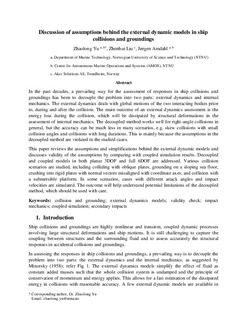| dc.contributor.author | Yu, Zhaolong | |
| dc.contributor.author | Liu, Zhenhui | |
| dc.contributor.author | Amdahl, Jørgen | |
| dc.date.accessioned | 2019-03-21T08:25:37Z | |
| dc.date.available | 2019-03-21T08:25:37Z | |
| dc.date.created | 2018-12-12T10:15:40Z | |
| dc.date.issued | 2019 | |
| dc.identifier.citation | Ships and Offshore Structures. 2019, . | nb_NO |
| dc.identifier.issn | 1744-5302 | |
| dc.identifier.uri | http://hdl.handle.net/11250/2590974 | |
| dc.description.abstract | In the past decades, a prevailing way for the assessment of responses in ship collisions and groundings has been to decouple the problem into two parts: external dynamics and internal mechanics. The external dynamics deals with global motions of the two interacting bodies prior to, during and after the collision. The main outcome of an external dynamics assessment is the energy loss during the collision, which will be dissipated by structural deformations in the assessment of internal mechanics. The decoupled method works well for right-angle collisions in general, but the accuracy can be much less in many scenarios, e.g. skew collisions with small collision angles and collisions with long durations. This is mainly because the assumptions in the decoupled method are violated in the studied cases. This paper reviews the assumptions and simplifications behind the external dynamic models and discusses validity of the assumptions by comparing with coupled simulation results. Decoupled and coupled models in both planar 3DOF and full 6DOF are addressed. Various collision scenarios are studied, including colliding with oblique plates, grounding on a sloping sea floor, crushing into rigid plates with normal vectors misaligned with coordinate axes, and collision with a submersible platform. In some scenarios, cases with different attack angles and impact velocities are simulated. The outcome will help understand potential limitations of the decoupled method, which should be used with care. | nb_NO |
| dc.language.iso | eng | nb_NO |
| dc.publisher | Taylor & Francis | nb_NO |
| dc.relation.uri | https://www.tandfonline.com/doi/full/10.1080/17445302.2018.1556234 | |
| dc.title | Discussion of assumptions behind the external dynamic models in ship collisions and groundings | nb_NO |
| dc.type | Journal article | nb_NO |
| dc.type | Peer reviewed | nb_NO |
| dc.description.version | acceptedVersion | nb_NO |
| dc.source.pagenumber | 18 | nb_NO |
| dc.source.journal | Ships and Offshore Structures | nb_NO |
| dc.identifier.doi | doi.org/10.1080/17445302.2018.1556234 | |
| dc.identifier.cristin | 1642003 | |
| dc.relation.project | Norges forskningsråd: 223254 | nb_NO |
| dc.description.localcode | Locked until 11.12.2019 due to copyright restrictions. This is an [Accepted Manuscript] of an article published by Taylor & Francis in [Ships and Offshore Structures ] on [11 Dec 2018], available at https://doi.org/10.1080/17445302.2018.1556234 | nb_NO |
| cristin.unitcode | 194,64,20,0 | |
| cristin.unitname | Institutt for marin teknikk | |
| cristin.ispublished | false | |
| cristin.fulltext | preprint | |
| cristin.qualitycode | 1 | |
